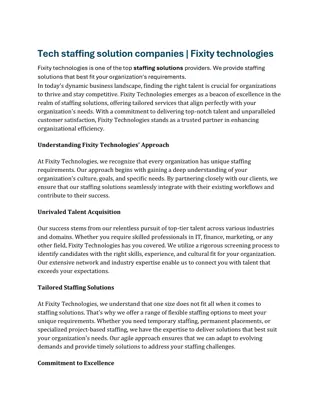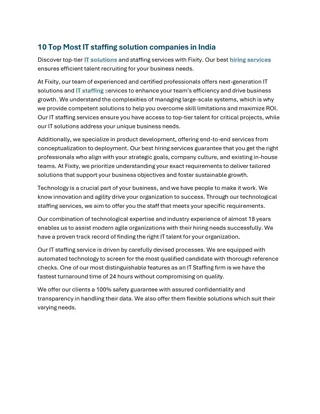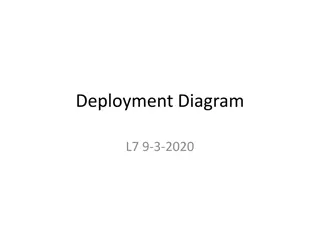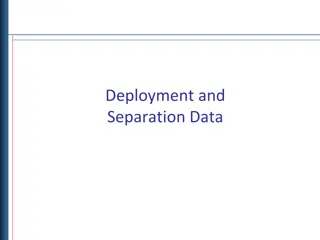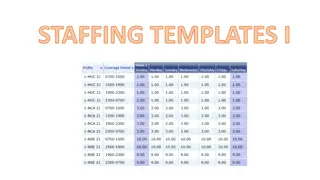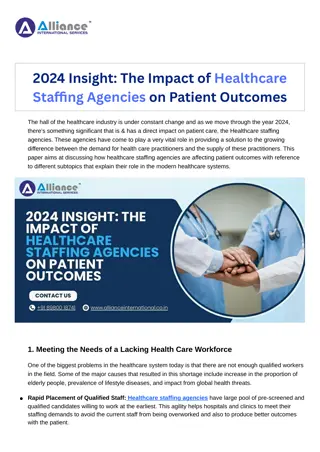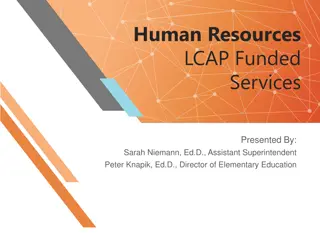
Maximizing Teacher Deployment for Student Success
Explore strategies and key elements for staffing, deployment, and capturing learning in educational settings. Learn about ensuring excellent teachers are deployed to high-needs schools, structuring systems for mutual consent, and improving teacher distribution for equitable student outcomes. Dive into essential metrics and key research findings for effective teacher deployment strategies. Join the Urban Schools Human Capital Academy for the best results in maximizing teacher talent for student achievement.
Uploaded on | 0 Views
Download Presentation

Please find below an Image/Link to download the presentation.
The content on the website is provided AS IS for your information and personal use only. It may not be sold, licensed, or shared on other websites without obtaining consent from the author. If you encounter any issues during the download, it is possible that the publisher has removed the file from their server.
You are allowed to download the files provided on this website for personal or commercial use, subject to the condition that they are used lawfully. All files are the property of their respective owners.
The content on the website is provided AS IS for your information and personal use only. It may not be sold, licensed, or shared on other websites without obtaining consent from the author.
E N D
Presentation Transcript
+ Staffing & Deployment Capturing Our Learning
+Overview 2 Purpose: To make the best use of talent by helping principals match teachers with the best role, as well as providing open market systems and incentives to ensure excellent teachers are deployed to high- needs schools Key Elements of Hiring & Selection Structuring Systems for Mutual Consent Limiting Transfer Periods Staffing High-Needs Schools with Great Talent Placing Surplus Teachers Effectively When Necessary for Budgetary Reasons Redesigning Layoff and Recall Policies See the Teacher ABC Tool and Executive Summary of the Teacher Puzzle Pieces for additional information USHCA URBAN SCHOOLS HUMAN CAPITAL ACADEMY Best People Best Results Urban Schools Human Capital Academy
+Key Research 3 No matter how you define teacher effectiveness, low-income, minority and lower achieving students end up with the least effective teachers Goldhaber, Lavery, & Theobald, 2015 Value-added Teacher experience Licensing scores Urban schools are often forced to hire teachers they don t want due to outdated transfer and excess rules 40 percent of school-level vacancies, on average, were filled by voluntary transfers or excessed teachers over whom schools had either no choice at all or limited choice. p.5. Levin, Mulhern, and Schunck, 2005 USHCA URBAN SCHOOLS HUMAN CAPITAL ACADEMY Best People Best Results Urban Schools Human Capital Academy
+Metrics 4 Deploy Teachers Deliberately Key metrics to understand performance in this function include: Distribution of teachers by performance rating and school need type (IV.C) Percentage of incoming and outgoing transfers by performance rating and school need type (IV.C) Percentage of new teachers in high-needs schools (IV.C) USHCA URBAN SCHOOLS HUMAN CAPITAL ACADEMY Best People Best Results Urban Schools Human Capital Academy
5 + Key Content Staffing & Deployment USHCA URBAN SCHOOLS HUMAN CAPITAL ACADEMY Best People Best Results
+ 6 A Reminder to Ponder The real goal is not to improve equitable teacher distribution. The real goals are to improve student learning, close achievement gaps, and create educational opportunities for all young people. Achieving equitable distribution of teachers is intended to be a means to that end. -- Ellen Behrstock-Sherratt, Ph.D. USHCA URBAN SCHOOLS HUMAN CAPITAL ACADEMY Best People Best Results
+ 7 Why this subject? Why now? Teacher effectiveness what we know now Power of an effective teacher and consequences of an ineffective one Dashboards by school and even by classroom Facing the facts courageous conversations USHCA URBAN SCHOOLS HUMAN CAPITAL ACADEMY Best People Best Results
+ 8 Who is an Effective Teacher ? At least one year s growth of students for year s time on standardized tests and other student outcome measures Final rating based on multiple measures: Observations by multiple observers Student achievement data Student surveys USHCA URBAN SCHOOLS HUMAN CAPITAL ACADEMY Best People Best Results
+ 9 How Do We Define High-Needs? High-needs schools can be defined as schools that have 51% or above of students on free and reduced lunch. High-needs schools also may have a preponderance of English Language Learners and special education students and often have higher turnover, fewer applicants, and greater numbers of vacancies, leading them to also be termed as hard-to-staff schools. -- USHCA USHCA URBAN SCHOOLS HUMAN CAPITAL ACADEMY Best People Best Results
+ 10 Ways of Measuring Inequity Between Schools Within Schools Access to effective teachers across schools Access to effective teachers across classes % of effective teachers by high/low- needs designation Level of effectiveness or experience of teacher compared to their assignment of students (Miami-Dade study) Distribution of highly-effective teachers Other indicators used % of vacancies and turnover in high/low-needs schools (stability of staff) Pre-service measures such as scoring on national tests (like Praxis) or SAT scores Effectiveness of principal Other indicators used % of minority/high-needs students taught by secondary teachers with deep content knowledge (subject majors or advanced degrees) Students assigned to first-year teachers USHCA URBAN SCHOOLS HUMAN CAPITAL ACADEMY Best People Best Results
+ 11 Impact on School Performance Research identified a teacher quality Tipping Point Proportion of low quality teachers is ~20% of school faculty Beyond 20% schools no longer have the ability to improve student achievement Source: Shields et al. 1999 USHCA URBAN SCHOOLS HUMAN CAPITAL ACADEMY Best People Best Results
+ 12 What We Now Know % first-year teachers at high-minority schools are almost twice as high as the % of such teachers at low-minority schools Less experienced teachers get assigned students who are twice as far behind (Miami-Dade study) Also, minority teachers tend to be assigned students who are further behind than students assigned to white teachers Teachers from more selective colleges tend to get higher achieving students than those who did not More of a problem in middle and high schools; less so in elementary schools Latino and African American students were three times as likely to have bottom quartile teachers in math and english language arts than their Asian and White counterparts USHCA URBAN SCHOOLS HUMAN CAPITAL ACADEMY Best People Best Results
+ 13 What We Now Know, (cont d) In Brief: Teachers in high-needs schools are less experienced, less effective, and less likely to stay Even though we know that Providing top-quartile teachers four years in a row is enough to close the achievement gap between white and African American students Second graders who started off below grade level and then had three top quartile teachers consecutively accelerated to proficiency USHCA URBAN SCHOOLS HUMAN CAPITAL ACADEMY Best People Best Results
+No Right Answer, but Some Ideas 14 Increase % of students taught by effective teachers $ to increase course load of effective teachers Provide extra support to any school with more than 20% ineffective teachers Help principals improve working conditions at high-needs schools Ensure HR policies support strategic and equitable staffing District examples Charlotte-Mecklenburg Project LIFT and Pittsburgh s Career Ladder Differentiated roles at high-needs schools with differentiated pay New York City Teacher leader role at high-needs school Part time teacher/part time instructional coach Denver Teacher leadership opportunities for instructional support and working conditions improvement USHCA URBAN SCHOOLS HUMAN CAPITAL ACADEMY Best People Best Results
+The Time is Now 15 To close the achievement gap, we must prioritize student needs first through state and local reforms and attract top teachers to our highest need communities, support their growth, and keep them in the classroom. Anthony Villagrosa 41st Mayor of Los Angeles USHCA URBAN SCHOOLS HUMAN CAPITAL ACADEMY Best People Best Results
16 + Tools and Activities USHCA URBAN SCHOOLS HUMAN CAPITAL ACADEMY Best People Best Results
+Tools 17 Levers for Impacting Equitable Distribution Highlights key district practices and policies that impact equitable distribution of teachers and principals from the Teacher and Principal ABC Tools Guiding Questions for Equitable Distribution Conversations Offers guiding questions district teams can use to hold conversations about equitable distribution Differentiating Services to Schools Establishes well-rounded criteria for identifying High-Needs or Highest- Needs schools in the school district, and then provides samples of differentiated services options to drive improved talent and performance USHCA URBAN SCHOOLS HUMAN CAPITAL ACADEMY Best People Best Results Urban Schools Human Capital Academy
+ Activity: Chauncey School District s Goals 1) Increase Student Learning by Increasing Effectiveness of All Educators; and 2) Close Achievement Gap by Leveraging High-Performers for High Need Students GOAL #1: Increase Effectiveness Educator Effectiveness (Student Outcomes, Instructional Practice) GOAL #2: Leverage High Performers for High Poverty Students USHCA URBAN SCHOOLS HUMAN CAPITAL ACADEMY Source: TNTP Best People Best Results 18
+ A Means to an End: What Are the Implications of Each Scenario for the Chauncey School District? 19 Scenario 1 Scenario 2 100% 100% 90% 90% 80% 80% % of teachers by effectiveness rating 70% 70% 60% 60% Highly Effective Highly Effective 50% 50% Effective Effective 40% 40% Developing Developing 30% 30% Ineffective Ineffective 20% 20% 10% 10% 0% 0% Highest Poverty Schools Lowest Poverty Schools Highest Poverty Schools Lowest Poverty Schools USHCA URBAN SCHOOLS HUMAN CAPITAL ACADEMY Best People Best Results
+How did Chauncey start down this path? 20 Step #1: Measure effective teaching and understand distribution of teacher effectiveness within the district Distribution of Teacher Effectiveness in Chauncey School District 100% 5% 11% 90% 80% % of teachers by effectiveness rating 45% 70% 49% Highly Effective 60% Effective 50% Developing 40% Ineffective 30% 43% Note: Chauncey District launched a new Teacher Evaluation System in SY 11-12. 37% 20% 10% 7% 3% 0% SY 11-12 SY 12-13 USHCA URBAN SCHOOLS HUMAN CAPITAL ACADEMY Best People Best Results
+ 21 Teacher Effectiveness Across Schools Based on Poverty Quintile Step #2: Measure access to effective teaching across schools based on poverty quintiles. 100% 90% 80% % of teachers by effectiveness rating 70% 60% Highly Effective Effective 50% Developing 40% Ineffective 30% Novice Teachers 20% Note: Poverty quintiles based on % of free and reduced lunch students 10% 0% Quintile 1 Quintile 2 Quintile 3 Quintile 4 Quintile 5 Lowest Highest Poverty Schools Poverty Schools USHCA URBAN SCHOOLS HUMAN CAPITAL ACADEMY Best People Best Results
+ Teacher Effectiveness Across Classrooms within ONE High-Poverty School in Chauncey 22 Step #3: Measure access to effective teaching across classrooms within schools 100% 90% 80% % of teachers by effectiveness rating 70% 60% Highly Effective 50% Effective 40% Developing 30% Ineffective 20% Novice Teachers 10% 0% Lowest Performing Students Middle Performing Students Highest Performing Students USHCA URBAN SCHOOLS HUMAN CAPITAL ACADEMY Best People Best Results
+Other HC Data Trends 23 Step #4: Analyze other HC data to better understand root causes and how to tackle this issue Over the past 2 years, of transferring high-performing teachers, 56% moved to a school with a LOWER poverty rate and only 22% moved to a school with a HIGHER poverty rate Teacher turnover rates in high poverty schools were twice as high as those in lower poverty schools Teacher turnover was also correlated with principal turnover in those schools USHCA URBAN SCHOOLS HUMAN CAPITAL ACADEMY Best People Best Results
+ Strategies up for Consideration 24 Provide its highest-poverty schools with dedicated recruitment resources 1. Provide its highest-poverty schools with teacher leader positions to provide coaching and support to new teachers 1. Developing school level teacher effectiveness reports to coach principals and principal managers on importance of placing highest effective teachers with highest need students 1. Which of these do you think is the strategy with the greatest potential for impact? Why? Is there another strategy you would recommend? USHCA URBAN SCHOOLS HUMAN CAPITAL ACADEMY Best People Best Results



